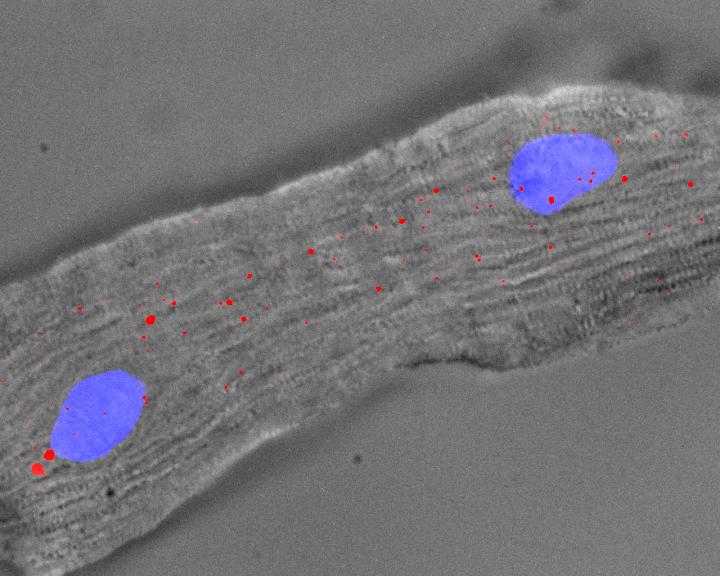
A nanolaser known as the spaser can serve as a super-bright, water-soluble, biocompatible probe capable of finding metastasized cancer cells in the blood stream and then killing these cells, according to a new research study.
The study found the spaser can be used as an optical probe and when released into the body (possibly through an injection or drinking a solution), it can find and go after circulating tumor cells (CTCs), stick to them and destroy these cells by breaking them apart to prevent cancer metastases. The spaser absorbs laser light, heats up, causes shock waves in the cell and destroys the cell membrane. The findings are published in the journal Nature Communications.
The spaser, which stands for surface plasmon amplification by stimulated emission of radiation, is a nanoparticle, about 20 nanometers in size or hundreds times smaller than human cells. It has folic acid attached to its surface, which allows selective molecular targeting of cancer cells. The folate receptor is commonly overexpressed on the surface of most human cancer cells and is weakly expressed in normal cells.
The discovery was made by researchers at Georgia State University, the University of Arkansas for Medical Sciences, the University of Arkansas at Little Rock and the Siberian Branch of the Russian Academy of Science.
“There is no other method to reliably detect and destroy CTCs,” said Dr. Mark Stockman, director of the Center for Nano-Optics and professor of physics at Georgia State. “This is the first. This biocompatible spaser can go after these cells and destroy them without killing or damaging healthy cells. Any other chemistry would damage and likely kill healthy cells. Our findings could play a pivotal role in providing a better, life-saving treatment option for cancer patients.”
Metastatic cancer occurs when cancer spreads to distant parts of the body, often to the bone, liver, lungs and brain, through a process called metastasis. Many types of cancers refer to this as stage IV cancer. Once cancer spreads, it can be difficult to control, and most metastatic cancer can’t be cured with current treatments, according to the National Institute of Health’s National Cancer Institute. One of the most dangerous ways metastasizing occurs is through the CTCs, which this study aims to detect and destroy using spasers.
The spasers used in this study measure just 22 nanometers, setting the record for the smallest nanolasers. A nanometer is one-billionth of a meter. Most results were obtained with a gold, spherical nanoparticle surrounded by a silica shell and covered with a uranine dye, which is widely used for tracing and biomedical diagnostics.
The researchers studied the spaser’s capabilities in vitro in human breast cancer cells with high folate receptor expression and endothelial cells with low folate receptor expression, as well as in mouse cells in vivo.
They found cells with spasers demonstrated high image contrasts with one or many individual “hot spots” at different laser energies above the spasing threshold. The presence of spasers was confirmed with several optical and electron microscopy techniques, which revealed an initial accumulation of individual spasers on the cell membrane followed by their entrance into the cell cytoplasm.
The study also found low toxicity of the spasers for human cells. At the same time, the spasers subjected to laser irradiation selectively killed the tumor cells without damaging the healthy ones.
Based on the study’s results, spaser-based therapeutic applications with high-contrast imaging is a promising field. The data suggest spasers have high potential as therapeutic and diagnostic agents that integrate optical diagnosis and photothermal-based cell killing, using just a few laser pulses to kill cancer cells.
Learn more: Spaser Can Detect, Kill Circulating Tumor Cells to Prevent Cancer Metastases, Study Finds
The Latest on: Spaser
[google_news title=”” keyword=”Spaser” num_posts=”10″ blurb_length=”0″ show_thumb=”left”]- Spasers explainedon October 16, 2023 at 1:17 pm
The spaser is a proposed nanoscale source of optical fields that is being investigated in a number of leading laboratories around the world. If realized, spasers could find a wide range of ...
- Publication highlightson July 6, 2021 at 3:50 am
Nanolasers on a subwavelength scale could potentially be fabricated based on the principle of surface plasmon amplification by stimulated emission of radiation (SPASER). However, a number of ...
- Light Propagation in Gain Mediaon December 4, 2020 at 9:24 am
Andrianov, E. S. Pukhov, A. A. Dorofeenko, A. V. Vinogradov, A. P. and Lisyansky, A. A. 2011. Dynamics of the transient regime of spaser. Journal of Communications ...
via Google News and Bing News











